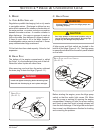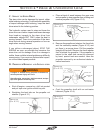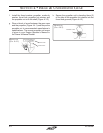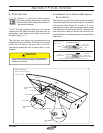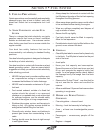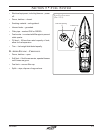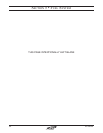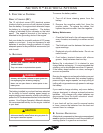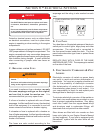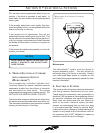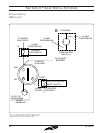
40 Outlaw
®
6.1
R
Speed changes you.
TM.
SeCtiOn 6 • eleCtriCal SySteMS
1. elecTrical sYsTeMs
DirecT currenT (Dc)
The 12 volt direct current (DC) electrical system
(similar to that in your car or truck) derives its power
from the battery. An engine-driven alternator keeps
the battery in a charged condition. The battery
voltage is indicated by the voltmeter on the helm
panel. The negative terminal of the battery is
attached to the grounding studs of the engine.
Ask your dealer for a careful analysis of DC power
needs on your boat. It may be necessary to add
batteries or auxiliary charging methods to supply
adequate power for any additional accessories you
wish to add.
a. baTTeries
The battery installed in your boat has been selected
for its ability to furnish starting power based on
engine starting requirements, as well as its ability to
power the DC accessories attached to the electrical
system. Your Engine Operator's Manual indicates
the recommended battery for the engine installed
in your boat.
To remove the battery cables:
1. Turn off all items drawing power from the
battery.
2. Remove the negative cable first, then the
positive cable. To replace the cables, first
replace the positive cable, then the negative.
Battery Maintenance
• Check the uid level in the cells approximately
every 4 weeks, and weekly in summer and hot
zones.
• The uid level must be between the lower and
upper markings.
• Replenish only with distilled water. Do not use
metal funnels.
• Coat battery terminal clamps with silicone
grease. Keep batteries clean and dry.
Battery life is shortened if it is drained to zero
charge before recharging. It is recommended that
a battery not be discharged more than 50 percent.
If the battery does become run down, recharge it
as soon as possible.
Running the engine to recharge the battery may not
be effective. The alternator only creates charging
power at higher engine speeds, so simply idling or
trolling will not generate enough power to recharge
the battery.
If you need to charge a battery, only use a battery
charger designed to charge automotive/marine
batteries. Use charger only when batteries are
disconnected from the boat's electrical circuit.
Follow the charger instructions.
If your boat will not be used for several weeks
or more, remove the batteries from the boat and
connect them to a charger.
b. iGniTion proTecTion
All electrical components in the engine compartment
must be ignition-protected to avoid the possibility of
creating sparks in a gasoline environment.
DO NOT USE JUMPER CABLES IN THE ENGINE
COMPARTMENT.
They can cause an explosion from sparks.
DANGER
!
! DANGER
A battery will explode if a ame or spark ignites the
free hydrogen given off during charging.
Never use an open ame or strike sparks in the
battery area.
To prevent arcing or damage to the alternator, always
disconnect battery cables before doing any work on
the engine's electrical system.
! CAUTION



